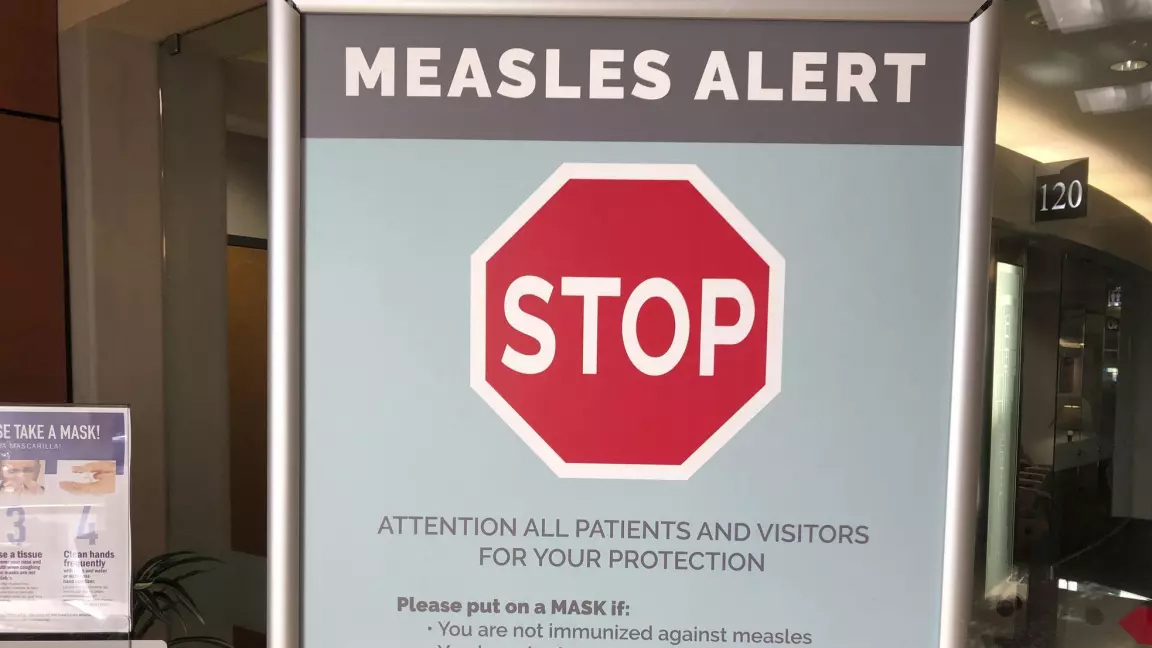Health
Why are so many Canadian children falling sick?
|
|
The flu has returned with a vengeance after being absent for a couple of years during the COVID-19 pandemic. It’s hitting children especially hard. Here’s what doctors say is happening, and why.
What flu strains are we seeing this flu season?
Based on predictions from the World Health Organization on what strains would appear, this year’s flu vaccine protects against two Influenza A strains – H3N2 and H1N1 – and two Influenza B strains which are called B/Victoria lineage and B/Yamagata lineage.
Right now, H3N2 is causing the vast majority of flu cases in Canada. It’s possible that the other strains could start circulating more widely and peak later in the flu season, doctors say.
Over the last decade, Influenza B strains have tended to arrive later in the season, said Dr. Allison McGeer, an infectious diseases specialist and microbiologist at Sinai Health Systems in Toronto.
Does H3N2 make people sicker than the other strains?
H3N2 can cause more severe illness than other strains, especially among seniors who are more vulnerable, partly because it mutates faster so people don’t have as much acquired immunity protection, said McGeer.
That’s because people appear to accumulate some degree of protection throughout their lives to H1N1 and Influenza B strains, but not for H3N2.
“(For) kids who haven’t really been exposed to influenza before to any significant degree, there’s not a lot of difference in severity between H1N1, H3N2 and B (strains),” McGeer said.
Why are so many kids getting sick right now?
The flu season started early this year, doctors say, which means kids started getting sick earlier. And COVID-19 safety measures, like masking, also kept other viruses like the flu at bay the previous two cold and flu seasons.
“We’re now seeing all our old viral foes coming back to play after being on hiatus for a couple of years,” said Dr. Justin Penner, pediatric infectious diseases specialist at the Children’s Hospital of Eastern Ontario and member of the Canadian Paediatric Society’s infectious diseases and immunization committee.
Kids under five years old are most at risk of getting seriously ill with flu, doctors say. And because of the COVID-19 pandemic precautions, the immune systems of many children under three haven’t previously come in contact with the virus.
“Kids between, you know, zero to three have about a 40 per cent chance of acquiring influenza in any given year,” McGeer said.
“We’ve now got like two and a half cohorts of kids who haven’t been exposed to influenza at all. So they’re all getting sick at the same time.”
Why do some people land in hospital with the flu?
In the vast majority of cases, flu can be treated at home, doctors say.
But like many illnesses, some cases end up being more serious, McGeer said.
“There’s an entire range (of reasons) from just severity of the influenza illness itself to complications,” she said.
Some flu patients might get pneumonia, for example, or a bacterial infection on top of the virus.
Myocarditis and encephalitis are other possible complications of the flu.
People who are immunocompromised can also be at higher risk of severe illness.
“Influenza can also trigger exacerbations of underlying illness,” McGeer said, including heart disease and stroke.
Seniors are also more prone to being hospitalized with the flu, but a higher risk in the older age demographic appears to be offset this year by public health measures such as continued masking in long-term care homes, she said.
Why are so many people reluctant to get the flu vaccine?
The Public Health Agency of Canada says it wants to achieve an 80 per cent flu vaccination rate by 2025, but the uptake falls far short of that each year.
The influenza vaccine has a “bad reputation” because it’s effective but not perfect, said Dr. James Kellner, a pediatric infectious disease specialist and epidemiologist at the University of Calgary.
Based on data from Australia, which already had its flu season, this year’s vaccine appears to be about 50 per cent effective in reducing severe illness from the flu, he said.
That’s a difference that people tend to undervalue, Kellner said.
“Looking at 50 per cent prevention of severe outcomes could certainly have saved a lot of misery across the country (this year).”
The fact that flu vaccinations are needed every year instead of getting a one-time shot also puts some people off, he said.
5:38
Health Matters: Families urged to get their children vaccinated as flu cases surge
Plus, “there’s so much fatigue” for public health measures from COVID-19, Kellner said.
“COVID vaccine initial uptake was so successful for a variety of reasons, but a big part of it was that there was this sense of public spirit around it in the collective willingness and desire to do the right thing,” he said.
“It seems that we’ve lost that quite a bit right now.”
Many people also don’t take the flu seriously enough or realize how severe it can be, especially for young children, Kellner said.
“There’s a sense that flu vaccine is not that important and so it’s missed out on a lot.”
Some people also mistakenly think they got the flu even though they were vaccinated, said Penner of the Canadian Paediatric Society.
“People’s perception of what influenza or the flu is, you know, could be a wide variety of different viruses,” he said.
Plus, if people do get the flu even though they’ve been immunized, the vaccine can make the illness less severe, Penner said.
How can we protect ourselves and our families?
The most effective ways to guard against the flu, experts say, are:
— Get the flu vaccine. Doctors say it’s not too late.
— Stay home if you feel unwell
— Masking
— Frequent handwashing
Health
April 22nd to 30th is Immunization Awareness Week – Oldies 107.7


<!–
isIE8 = true;
Date.now = Date.now || function() return +new Date; ;
Health
AHS confirms case of measles in Edmonton – CityNews Edmonton


Alberta Health Services (AHS) has confirmed a case of measles in Edmonton, and is advising the public that the individual was out in public while infectious.
Measles is an extremely contagious disease that is spread easily through the air, and can only be prevented through immunization.
AHS says individuals who were in the following locations during the specified dates and times, may have been exposed to measles.
- April 16
- Edmonton International Airport, international arrivals and baggage claim area — between 3:20 p.m. and 6 p.m.
- April 20
- Stollery Children’s Hospital Emergency Department — between 5 a.m. to 3 p.m.
- April 22
- 66th Medical Clinic (13635 66 St NW Edmonton) — between 12:15 p.m. to 3:30 p.m.
- Pharmacy 66 (13637 66 St NW Edmonton) — between 12:15 p.m. to 3:30 p.m.
- April 23
- Stollery Children’s Hospital Emergency Department — between 4:40 a.m. to 9:33 a.m.
AHS says anyone who attended those locations during those times is at risk of developing measles if they’ve not had two documented doses of measles-containing vaccine.
Those who have not had two doses, who are pregnant, under one year of age, or have a weakened immune system are at greatest risk of getting measles and should contact Health Link at 1-877-720-0707.
Symptoms
Symptoms of measles include a fever of 38.3° C or higher, cough, runny nose, and/or red eyes, a red blotchy rash that appears three to seven days after fever starts, beginning behind the ears and on the face and spreading down the body and then to the arms and legs.
If you have any of these symptoms stay home and call Health Link.
In Alberta, measles vaccine is offered, free of charge, through Alberta’s publicly funded immunization program. Children in Alberta typically receive their first dose of measles vaccine at 12 months of age, and their second dose at 18 months of age.
Health
U.S. tightens rules for dairy cows a day after bird flu virus fragments found in pasteurized milk samples – Toronto Star


/* OOVVUU Targeting */
const path = ‘/news/canada’;
const siteName = ‘thestar.com’;
let domain = ‘thestar.com’;
if (siteName === ‘thestar.com’)
domain = ‘thestar.com’;
else if (siteName === ‘niagarafallsreview.ca’)
domain = ‘niagara_falls_review’;
else if (siteName === ‘stcatharinesstandard.ca’)
domain = ‘st_catharines_standard’;
else if (siteName === ‘thepeterboroughexaminer.com’)
domain = ‘the_peterborough_examiner’;
else if (siteName === ‘therecord.com’)
domain = ‘the_record’;
else if (siteName === ‘thespec.com’)
domain = ‘the_spec’;
else if (siteName === ‘wellandtribune.ca’)
domain = ‘welland_tribune’;
else if (siteName === ‘bramptonguardian.com’)
domain = ‘brampton_guardian’;
else if (siteName === ‘caledonenterprise.com’)
domain = ‘caledon_enterprise’;
else if (siteName === ‘cambridgetimes.ca’)
domain = ‘cambridge_times’;
else if (siteName === ‘durhamregion.com’)
domain = ‘durham_region’;
else if (siteName === ‘guelphmercury.com’)
domain = ‘guelph_mercury’;
else if (siteName === ‘insidehalton.com’)
domain = ‘inside_halton’;
else if (siteName === ‘insideottawavalley.com’)
domain = ‘inside_ottawa_valley’;
else if (siteName === ‘mississauga.com’)
domain = ‘mississauga’;
else if (siteName === ‘muskokaregion.com’)
domain = ‘muskoka_region’;
else if (siteName === ‘newhamburgindependent.ca’)
domain = ‘new_hamburg_independent’;
else if (siteName === ‘niagarathisweek.com’)
domain = ‘niagara_this_week’;
else if (siteName === ‘northbaynipissing.com’)
domain = ‘north_bay_nipissing’;
else if (siteName === ‘northumberlandnews.com’)
domain = ‘northumberland_news’;
else if (siteName === ‘orangeville.com’)
domain = ‘orangeville’;
else if (siteName === ‘ourwindsor.ca’)
domain = ‘our_windsor’;
else if (siteName === ‘parrysound.com’)
domain = ‘parrysound’;
else if (siteName === ‘simcoe.com’)
domain = ‘simcoe’;
else if (siteName === ‘theifp.ca’)
domain = ‘the_ifp’;
else if (siteName === ‘waterloochronicle.ca’)
domain = ‘waterloo_chronicle’;
else if (siteName === ‘yorkregion.com’)
domain = ‘york_region’;
let sectionTag = ”;
try
if (domain === ‘thestar.com’ && path.indexOf(‘wires/’) = 0)
sectionTag = ‘/business’;
else if (path.indexOf(‘/autos’) >= 0)
sectionTag = ‘/autos’;
else if (path.indexOf(‘/entertainment’) >= 0)
sectionTag = ‘/entertainment’;
else if (path.indexOf(‘/life’) >= 0)
sectionTag = ‘/life’;
else if (path.indexOf(‘/news’) >= 0)
sectionTag = ‘/news’;
else if (path.indexOf(‘/politics’) >= 0)
sectionTag = ‘/politics’;
else if (path.indexOf(‘/sports’) >= 0)
sectionTag = ‘/sports’;
else if (path.indexOf(‘/opinion’) >= 0)
sectionTag = ‘/opinion’;
} catch (ex)
const descriptionUrl = ‘window.location.href’;
const vid = ‘mediainfo.reference_id’;
const cmsId = ‘2665777’;
let url = `https://pubads.g.doubleclick.net/gampad/ads?iu=/58580620/$domain/video/oovvuu$sectionTag&description_url=$descriptionUrl&vid=$vid&cmsid=$cmsId&tfcd=0&npa=0&sz=640×480&ad_rule=0&gdfp_req=1&output=vast&unviewed_position_start=1&env=vp&impl=s&correlator=`;
url = url.split(‘ ‘).join(”);
window.oovvuuReplacementAdServerURL = url;
Infected cows were already prohibited from being transported out of state, but that was based on the physical characteristics of the milk, which looks curdled when a cow is infected, or a cow has decreased lactation or low appetite, both symptoms of infection.
function buildUserSwitchAccountsForm()
var form = document.getElementById(‘user-local-logout-form-switch-accounts’);
if (form) return;
// build form with javascript since having a form element here breaks the payment modal.
var switchForm = document.createElement(‘form’);
switchForm.setAttribute(‘id’,’user-local-logout-form-switch-accounts’);
switchForm.setAttribute(‘method’,’post’);
switchForm.setAttribute(‘action’,’https://www.thestar.com/tncms/auth/logout/?return=https://www.thestar.com/users/login/?referer_url=https%3A%2F%2Fwww.thestar.com%2Fnews%2Fcanada%2Fu-s-tightens-rules-for-dairy-cows-a-day-after-bird-flu-virus-fragments-found%2Farticle_985b0bac-0252-11ef-abc6-eb884d6a1f0c.html’);
switchForm.setAttribute(‘style’,’display:none;’);
var refUrl = document.createElement(‘input’); //input element, text
refUrl.setAttribute(‘type’,’hidden’);
refUrl.setAttribute(‘name’,’referer_url’);
refUrl.setAttribute(‘value’,’https://www.thestar.com/news/canada/u-s-tightens-rules-for-dairy-cows-a-day-after-bird-flu-virus-fragments-found/article_985b0bac-0252-11ef-abc6-eb884d6a1f0c.html’);
var submit = document.createElement(‘input’);
submit.setAttribute(‘type’,’submit’);
submit.setAttribute(‘name’,’logout’);
submit.setAttribute(‘value’,’Logout’);
switchForm.appendChild(refUrl);
switchForm.appendChild(submit);
document.getElementsByTagName(‘body’)[0].appendChild(switchForm);
function handleUserSwitchAccounts()
window.sessionStorage.removeItem(‘bd-viafoura-oidc’); // clear viafoura JWT token
// logout user before sending them to login page via return url
document.getElementById(‘user-local-logout-form-switch-accounts’).submit();
return false;
buildUserSwitchAccountsForm();
console.log(‘=====> bRemoveLastParagraph: ‘,0);
-



 Politics19 hours ago
Politics19 hours agoOpinion: Fear the politicization of pensions, no matter the politician
-



 Politics18 hours ago
Politics18 hours agoPecker’s Trump Trial Testimony Is a Lesson in Power Politics
-



 Science19 hours ago
Science19 hours agoNASA Celebrates As 1977’s Voyager 1 Phones Home At Last
-
Media18 hours ago
B.C. puts online harms bill on hold after agreement with social media companies
-
Business18 hours ago
Oil Firms Doubtful Trans Mountain Pipeline Will Start Full Service by May 1st
-
Investment20 hours ago
FLAGSHIP COMMUNITIES REAL ESTATE INVESTMENT TRUST ANNOUNCES CLOSING OF APPROXIMATELY US
-
Art20 hours ago
Turner Prize: Shortlisted artist showcases Scottish Sikh community
-
Media12 hours ago
B.C. online harms bill on hold after deal with social media firms





